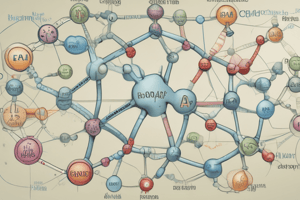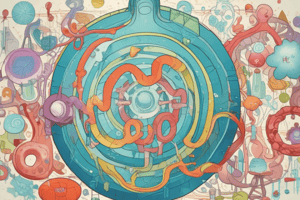Podcast
Questions and Answers
How are nonessential amino acids defined?
How are nonessential amino acids defined?
- Cannot be synthesized by the body
- Can be synthesized from essential amino acids
- Can be synthesized in sufficient amounts from metabolic intermediates (correct)
- Must be obtained only from the diet
Glucogenic amino acids can be converted into glucose in the liver and kidney.
Glucogenic amino acids can be converted into glucose in the liver and kidney.
True (A)
Glutamine is synthesized from glutamate by __________ synthetase.
Glutamine is synthesized from glutamate by __________ synthetase.
glutamine
Match the following amino acids with their conversion products:
Match the following amino acids with their conversion products:
Flashcards are hidden until you start studying
Study Notes
Catabolism of Amino Acids
Classification of Amino Acids
- Amino acids can be classified as glucogenic, ketogenic, or both based on which of the seven intermediates are produced during their catabolism.
- Glucogenic amino acids: yield pyruvate or one of the intermediates of the citric acid cycle, and can give rise to the net formation of glucose in the liver and kidney.
- Ketogenic amino acids: yield either acetoacetate or one of its precursors (acetyl CoA or acetoacetyl CoA), and are exclusively ketogenic (e.g., leucine and lysine).
Biosynthesis of Nonessential Amino Acids
- Nonessential amino acids are synthesized from intermediates of metabolism or from essential amino acids (e.g., tyrosine and cysteine).
- Synthesis from α-keto acids: alanine, aspartate, and glutamate are synthesized by transfer of an amino group to the α-keto acids pyruvate, oxaloacetate, and α-keto-glutarate, respectively.
- Synthesis by amidation: glutamine is formed from glutamate by glutamine synthetase.
- Synthesis of proline: glutamate is converted to proline by cyclization and reduction reactions.
- Synthesis of serine: serine arises from 3-phosphoglycerate, an intermediate in glycolysis.
Catabolism of Amino Acid Nitrogen
- Removing the α-amino group is essential for producing energy from any amino acid, and is an obligatory step in the catabolism of all amino acids.
- Transamination: the first step in the catabolism of most amino acids is the transfer of their α-amino group to α-ketoglutarate.
- Glutamate dehydrogenase: the oxidative deamination of amino acids results in the liberation of the amino group as free ammonia (NH3).
- Transport of ammonia to the liver: glutamine synthetase combines ammonia (NH3) with glutamate to form glutamine, which is transported in the blood to the liver where it is cleaved by glutaminase to produce glutamate and free ammonia.
Studying That Suits You
Use AI to generate personalized quizzes and flashcards to suit your learning preferences.



